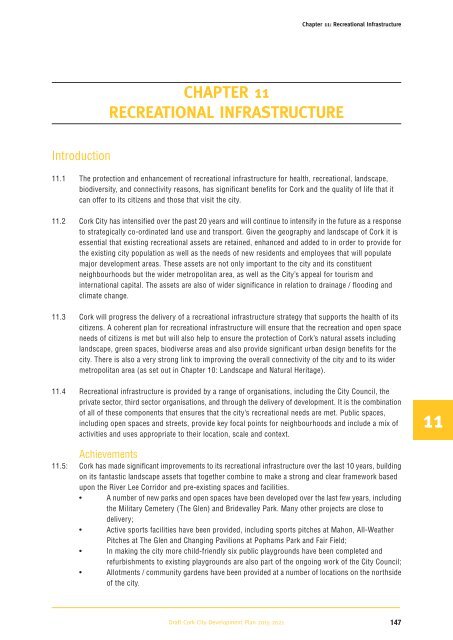Volume 1 Written Statement
Volume 1 Written Statement
Volume 1 Written Statement
Create successful ePaper yourself
Turn your PDF publications into a flip-book with our unique Google optimized e-Paper software.
Chapter 11: Recreational Infrastructure<br />
x<br />
CHAPTER 11<br />
RECREATIONAL INFRASTRUCTURE<br />
Introduction<br />
11.1 The protection and enhancement of recreational infrastructure for health, recreational, landscape,<br />
biodiversity, and connectivity reasons, has significant benefits for Cork and the quality of life that it<br />
can offer to its citizens and those that visit the city.<br />
11.2 Cork City has intensified over the past 20 years and will continue to intensify in the future as a response<br />
to strategically co-ordinated land use and transport. Given the geography and landscape of Cork it is<br />
essential that existing recreational assets are retained, enhanced and added to in order to provide for<br />
the existing city population as well as the needs of new residents and employees that will populate<br />
major development areas. These assets are not only important to the city and its constituent<br />
neighbourhoods but the wider metropolitan area, as well as the City’s appeal for tourism and<br />
international capital. The assets are also of wider significance in relation to drainage / flooding and<br />
climate change.<br />
11.3 Cork will progress the delivery of a recreational infrastructure strategy that supports the health of its<br />
citizens. A coherent plan for recreational infrastructure will ensure that the recreation and open space<br />
needs of citizens is met but will also help to ensure the protection of Cork’s natural assets including<br />
landscape, green spaces, biodiverse areas and also provide significant urban design benefits for the<br />
city. There is also a very strong link to improving the overall connectivity of the city and to its wider<br />
metropolitan area (as set out in Chapter 10: Landscape and Natural Heritage).<br />
11.4 Recreational infrastructure is provided by a range of organisations, including the City Council, the<br />
private sector, third sector organisations, and through the delivery of development. It is the combination<br />
of all of these components that ensures that the city’s recreational needs are met. Public spaces,<br />
including open spaces and streets, provide key focal points for neighbourhoods and include a mix of<br />
activities and uses appropriate to their location, scale and context.<br />
11<br />
Achievements<br />
11.5: Cork has made significant improvements to its recreational infrastructure over the last 10 years, building<br />
on its fantastic landscape assets that together combine to make a strong and clear framework based<br />
upon the River Lee Corridor and pre-existing spaces and facilities.<br />
• A number of new parks and open spaces have been developed over the last few years, including<br />
the Military Cemetery (The Glen) and Bridevalley Park. Many other projects are close to<br />
delivery;<br />
• Active sports facilities have been provided, including sports pitches at Mahon, All-Weather<br />
Pitches at The Glen and Changing Pavilions at Pophams Park and Fair Field;<br />
• In making the city more child-friendly six public playgrounds have been completed and<br />
refurbishments to existing playgrounds are also part of the ongoing work of the City Council;<br />
• Allotments / community gardens have been provided at a number of locations on the northside<br />
of the city.<br />
Draft Cork City Development Plan 2015-2021<br />
147


